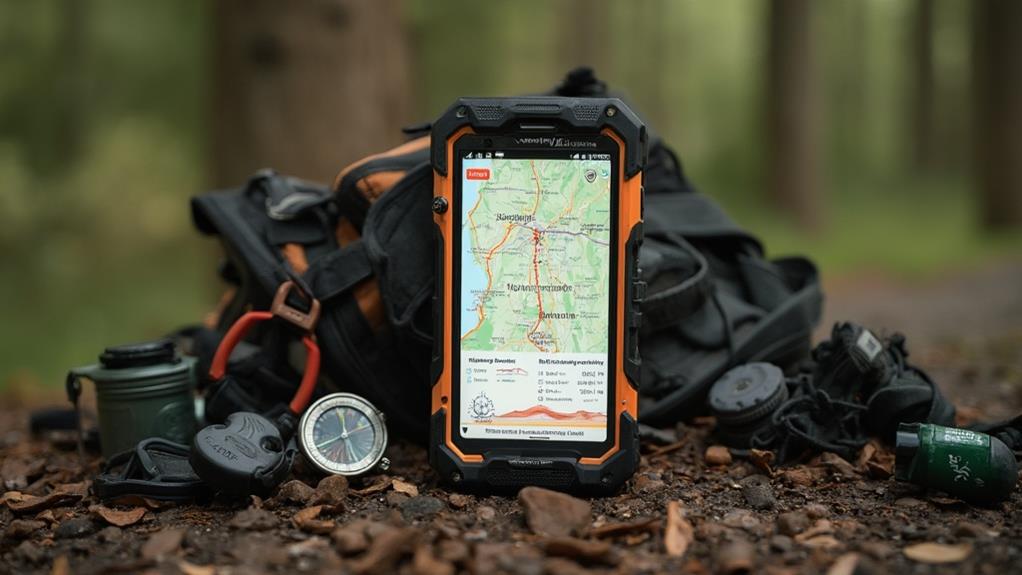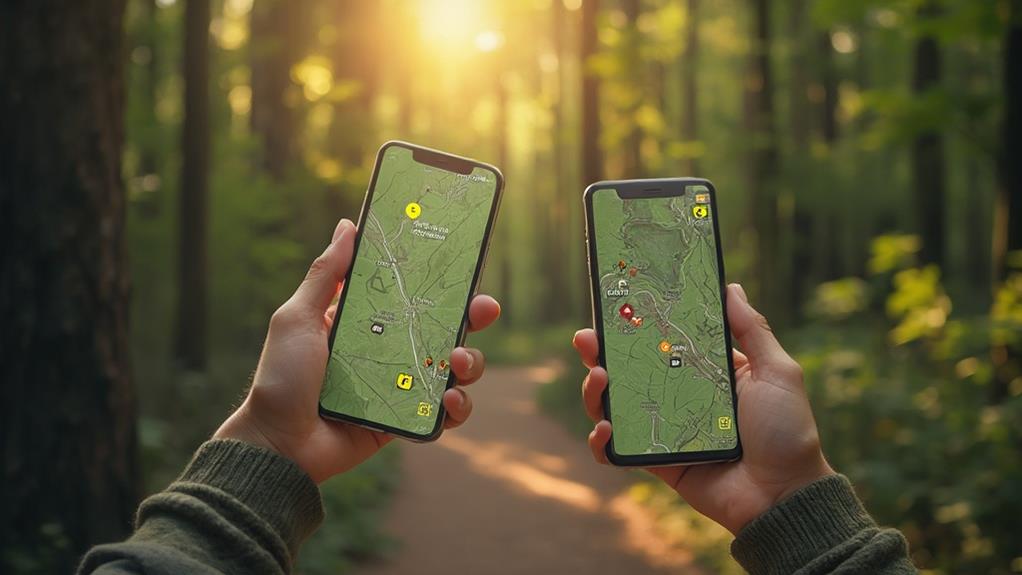Selecting the right apps can transform a beginner's hiking experience by enhancing wayfinding, safety, and tracking. AllTrails and Komoot provide intuitive route planning with customizable mapping, while Gaia GPS offers robust offline functionalities for remote areas. For safety, look for apps featuring SOS alerts and real-time location sharing; these are essential for traversing unfamiliar terrains. Consider whether a paid subscription is justified, as it can provide offline maps and advanced features. Additionally, apps with community-generated content like user reviews can enrich your hiking knowledge. Explore further to discover which features align with your hiking needs and preferences.
Key Takeaways
- AllTrails App: Offers a vast trail database with user reviews, perfect for beginners to find suitable hikes.
- Komoot App: Provides customizable route planning with offline access, enhancing navigation for new hikers.
- OS Maps App: Features detailed Ordnance Survey maps and real-time GPS, aiding navigation for novices.
- SOS Functionality: Critical safety feature in hiking apps that ensures immediate emergency alerts and precise location sharing.
- User-Friendly Interfaces: Apps like AllTrails offer intuitive designs, simplifying navigation and route planning for beginner hikers.
Essential Navigation Apps
For beginner hikers venturing into the great outdoors, selecting the right wayfinding app is essential for both safety and enjoyment.
The OS Maps App stands out with its map accessibility, offering 607 detailed maps of Great Britain. Its offline functionality guarantees hikers can download routes and use GPS tracking without needing an internet connection, available through an annual premium subscription of £34.99.
The AllTrails App provides access to an extensive database of over 400,000 trails worldwide. Its Pro membership offers offline map access, guaranteeing continuous guidance in areas with poor reception. Users can share trail experiences, making it a community-driven resource for discovering new paths.
Kamoot excels with its interactive drag-and-drop route planning tool, providing practical advice through community tips. Its offline functionality is supported by a premium subscription, priced at £59.99 annually, aiding hikers in maneuvering even the most remote trails.
Gaia GPS is tailored for off-grid navigation, featuring detailed topographic maps from international sources. Despite reported syncing issues, its map accessibility makes it a valuable tool for hikers venturing off the beaten path.
Caltopo is ideal for those who prioritize detailed trip planning, offering excellent route building and editing features, along with high-resolution terrain data.
Must-Have Safety Features

Safety-oriented features in hiking apps are indispensable for ensuring a secure outdoor experience. Among the most important is the SOS functionality, which empowers users to send immediate emergency alerts and precise location data to rescue services when distress arises. This feature is essential for emergency preparedness, allowing hikers to respond swiftly in life-threatening situations.
Additionally, real-time location sharing allows adventurers to keep trusted contacts informed of their whereabouts, providing an extra layer of security, particularly in unfamiliar or remote terrains.
Offline map access is another significant safety component, enabling hikers to navigate accurately even when mobile signals fail. This feature reduces the likelihood of getting lost, which is essential for both novice and seasoned hikers.
Incorporating weather alerts into these apps further enhances safety by notifying users of sudden weather changes, such as storms or temperature fluctuations, therefore aiding in better safety training and preparation for potential hazards.
Top Tracking Tools
Equipped with advanced features, top tracking tools in hiking apps offer invaluable assistance to beginner hikers seeking to enhance their outdoor adventures. These tools facilitate thorough tracking, ensuring that novices can confidently navigate trails while keeping a precise record of their journey.
For instance, the AllTrails App boasts a vast database of over 400,000 trails worldwide, enabling users to filter by difficulty and length, which simplifies the selection process. In addition, user reviews and trail sharing options allow for informed decision-making, fostering a community-driven approach to exploring new terrains.
- AllTrails App: Over 400,000 global trails with user reviews and trail sharing.
- Komoot App: Customizable route planning via drag-and-drop, ideal for personalized adventures.
- Gaia GPS: Extensive offline capabilities with detailed topographic maps for remote navigation.
- OS Maps App: Access to 607 Ordnance Survey maps of Great Britain with offline routes.
- MapOut App: Offline route planning and track recording with GPX file import/export.
These apps not only enhance navigation but also promote safety and preparedness by allowing users to share their trails with others.
Beginner hikers can therefore set out on their journeys with confidence, backed by reliable tools and community insights.
Comparing Free and Paid Options

When selecting a hiking app, beginners should weigh the benefits of cost-effective free options against the enhanced features available in paid subscriptions.
Free versions like AllTrails and Komoot offer basic navigation tools, but investing in premium services can provide value through advanced functionalities such as offline access and detailed terrain data.
Cost-Effective App Choices
Steering through the vast selection of hiking apps can be overwhelming, but understanding the balance between free and paid options is crucial for making cost-effective decisions.
With a multitude of budget friendly options available, choosing the right app involves a careful evaluation of subscription comparisons to guarantee the best value for money. Each app has its unique offerings that cater to different hiking needs and preferences.
- AllTrails: Free users can access over 400,000 trails, while the Pro version ($35.99/year) offers offline maps and advanced features.
- Outdooractive: The Pro version (£2.23/month) enhances the free basic service with worldwide maps and community routes.
- Gaia GPS: Offers a Premium subscription for $39.99/year, ideal for international trekking with extensive offline maps.
- Komoot: Provides free access with a premium option (€4.99/month) for offline maps and advanced planning features.
- Topo GPS: Free basic version with an OS maps subscription (£24.99/year) for enhanced navigation.
When comparing these options, evaluating your specific hiking needs and how each app aligns with your budget can guide you to the most cost-effective choice.
Prioritizing features such as offline maps or advanced route planning will help determine the right investment for your hiking adventures.
Free Versus Subscription Features
How do you determine the right balance between free access and premium features when selecting a hiking app? The decision often hinges on reviewing feature limitations against the subscription benefits.
Free versions of popular apps like AllTrails and Komoot provide essential access to trail databases and basic route planning. However, they restrict advanced functionalities such as offline maps to paid subscriptions, which can be critical for remote hiking areas without cellular coverage.
For instance, Gaia GPS's free version introduces users to basic navigation, but its $39.99/year Premium subscription is indispensable for extensive offline maps, particularly for international excursions.
Similarly, Outdooractive's free version supports basic route planning, but the Pro version at £2.23/month offers essential offline map downloads and exclusive content.
Other apps follow this model—FATMAP's Explore subscription at £24.99/year includes advanced terrain visualization, enhancing the hiking experience greatly beyond the free version's limited scope.
OS Maps also exemplifies this trend, where the Premium subscription at £29.99/year removes map quantity restrictions and adds GPS tracking.
Ultimately, evaluating your hiking needs and challenges is fundamental to determining whether these subscription benefits justify bypassing feature limitations in free versions.
Evaluating Value for Money
Choosing the right hiking app involves a careful evaluation of the value offered by both free and paid options. Free versions, like those from AllTrails and Komoot, provide essential features such as route planning and community-generated trails. These can be adequate for beginners who are just starting to explore hiking.
On the other hand, paid subscriptions like Gaia GPS and Outdooractive Pro offer enhanced features, including offline maps and detailed topographical data, at a cost. When comparing free and paid options, it's vital to contemplate user reviews and feature comparisons to determine what best suits your needs.
Key considerations include:
- Offline Capabilities: Fundamental for areas with limited connectivity.
- Advanced Mapping Tools: More detailed visualizations can improve navigation.
- Route Customization: Tailoring routes to individual preferences enhances the experience.
- Cost vs. Frequency of Use: Regular hikers may benefit more from premium options.
- Trial Periods: Options like OS Maps' 14-day trial allow users to test features before committing.
Ultimately, evaluating the cost versus benefits is essential. While free apps may suffice for casual hikers, investing in premium subscriptions can greatly improve navigation and safety for serious enthusiasts.
Understanding your requirements will guide your decision-making process.
User-Friendly Interfaces

User-friendly interfaces are essential for beginner hikers, as they facilitate intuitive navigation and accessible design elements that enhance the overall experience.
Apps like AllTrails and Komoot excel with simplified route planning and interactive maps, allowing users to efficiently create and modify their hiking paths.
With features such as easy-to-use filters and offline map access, these apps provide practical solutions for novices to explore trails confidently and without technical difficulties.
Intuitive Navigation Tools
For beginner hikers venturing into the great outdoors, traversing trails can be a formidable task, but intuitive navigation tools offered by modern hiking apps greatly ease the process.
These apps feature visual mapping and route customization capabilities that help novices navigate even the most challenging terrains with confidence. AllTrails and Komoot, for example, simplify route selection by allowing users to filter trails based on difficulty, length, and user ratings. This level of customization guarantees that hikers can tailor their experience to match their skill level and preferences.
Intuitive mapping tools are a standout feature in apps like Gaia GPS and Outdooractive. These platforms allow users to create and customize routes effortlessly using drag-and-drop features.
Furthermore, the OS Maps app enhances accuracy with live GPS functionality, making sure hikers remain on the correct path.
Offline capabilities are essential for remote hiking:
- MapOut and FATMAP support offline map downloads.
- Access maps without a mobile signal.
- Maintains usability in remote areas.
- Prevents data dependency.
- Enhances safety and independence.
Community-driven platforms such as AllTrails further assist beginners by offering shared experiences and tips from seasoned hikers, enriching their learning journey through user-generated content.
Simplified Route Planning
Maneuvering the world of hiking is made remarkably easier through simplified route planning, thanks to the user-friendly interfaces of modern hiking apps.
Trail customization and beginner friendly features are at the forefront of applications like AllTrails and Komoot, which allow novice hikers to filter trails by difficulty, length, and suitability. This makes the intimidating task of selecting an appropriate route considerably more straightforward.
Apps such as Gaia GPS enhance the navigation experience by providing detailed offline maps, allowing users to view additional landmarks. This integration is particularly beneficial for beginners, offering a thorough perspective of the trail environment and reducing the likelihood of getting lost.
OS Maps further supports novices with its seamless integration with printed maps, facilitating a smooth change for those less familiar with digital tools.
Outdooractive stands out with its drag-and-drop functionality, simplifying the process of customizing hikes to suit individual preferences. This feature is particularly advantageous for those new to outdoor activities, presenting a user-friendly entry into route planning.
Similarly, basic route planning capabilities in apps like FATMAP and MapOut enable users to plot journeys with minimal effort, ensuring that even the most inexperienced hikers can confidently explore trails without requiring advanced navigation skills.
Accessible Design Elements
Steering through the complexities of hiking is made considerably more approachable through accessible design elements, which are a hallmark of leading hiking apps.
User-friendly interfaces in apps like AllTrails and Komoot prioritize intuitive navigation by integrating clear icons and straightforward menus. Such design accessibility guarantees that even novices can effortlessly engage with essential features.
Customizable map views in Gaia GPS and OS Maps are another crucial visual element, allowing users to switch between terrain and trail information with ease. This adaptability supports beginner hikers in making informed decisions about their routes.
For those new to hiking, the ability to filter trails based on difficulty, distance, and user ratings simplifies the selection process. AllTrails excels in this regard, offering a tailored experience that aligns with individual skill levels and preferences.
Additionally, interactive tutorials in apps like Outdooractive and FATMAP provide step-by-step guidance, enhancing users' confidence in traversing trails safely. Offline capabilities in Gaia GPS and OS Maps further bolster safety by guaranteeing access to maps and navigation tools even without a mobile signal.
Key design features include:
- Intuitive navigation with clear icons
- Customizable map views
- Trail filtering by difficulty and ratings
- Interactive tutorials for navigation
- Offline access to essential maps
These thoughtful design elements contribute greatly to a seamless hiking experience for beginners.
Community and Social Features

How do beginner hikers find the perfect trail while fostering a sense of community? Many hiking apps integrate trail sharing and group dynamics to facilitate this process. Platforms like AllTrails and Komoot allow users to share their trail experiences, complete with tips and photos. This not only provides a valuable resource for beginners but also establishes a community where knowledge is exchanged freely.
AllTrails, with its extensive database of over 400,000 trails, offers a treasure trove of insights via user-generated reviews and comments, making it easier for beginners to select trails that match their skill level and preferences.
Furthermore, apps such as Gaia GPS and Outdooractive enhance these community interactions by offering unique features. Gaia GPS provides community-generated maps that detail lesser-known trails and landmarks, encouraging exploration beyond conventional routes.
Meanwhile, Outdooractive facilitates connection among hikers through social features like event calendars and local meetups. These options enable novice hikers to join groups, participate in shared hikes, and learn from seasoned enthusiasts, thereby improving their skills in a collaborative environment.
Frequently Asked Questions
Is Alltrails or Komoot Better?
Choosing between AllTrails and Komoot depends on user preferences. AllTrails features extensive user-generated trails and a user-friendly interface, while Komoot navigation offers interactive route planning and emphasizes social connectivity. Both provide offline maps and community insights.
What App Is Good to Track Hiking Miles?
For accurate distance measurement and robust GPS features, AllTrails and Gaia GPS are highly recommended. AllTrails provides an extensive trail database with community sharing, while Gaia GPS offers detailed topographic maps, especially beneficial for remote hiking excursions.
Is Alltrails Better Than OS Maps?
AllTrails features a user-friendly platform with community-driven insights, ideal for casual hikers. In contrast, OS Maps advantages include detailed topographic data and robust route management, catering to those requiring extensive navigation, particularly within the UK.
How to Track a Hiker?
To guarantee effective tracking of a hiker, employ GPS-enabled apps and wearable devices for real-time navigation. Utilize location sharing for safety, and review trail conditions through user feedback to enhance hiking safety and provide valuable navigation tips.
Conclusion
In summary, selecting the appropriate applications for beginner hikers involves evaluating essential navigation capabilities, indispensable safety features, and top-tier tracking tools. A thorough comparison of free and paid options reveals diverse functionalities that cater to varying needs and budgets. Prioritizing user-friendly interfaces guarantees accessibility and ease of use, enhancing the hiking experience. Additionally, community and social features contribute to a sense of belonging and shared adventure, thereby enriching the overall outdoor activity.